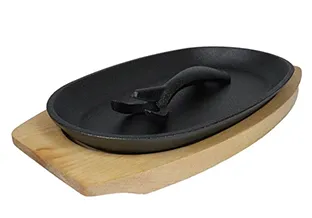
what are dutch ovens made out of
Dutch ovens are a beloved kitchen staple, known for their versatility and durability in cooking. Their design and materials have evolved over time, but they are primarily made from several key materials that contribute to their performance and longevity. Understanding what Dutch ovens are made of can help cooks choose the right one for their culinary needs and ensure they make the best use of this essential cookware.
Cast Iron The Traditional Choice
The most classic material for Dutch ovens is cast iron, which has been used for centuries. Cast iron is favored for its excellent heat retention and even heating properties, making it ideal for slow cooking, braising, baking, and frying. When properly seasoned, cast iron Dutch ovens develop a natural non-stick surface, which enhances the flavor of dishes while making cleanup easier.
The surface of cast iron can be enameled or uncoated. Enameled cast iron Dutch ovens have a glass-like coating that prevents rust and eliminates the need for seasoning. This type of Dutch oven is available in a variety of colors and patterns, making it as much a decorative item as a practical one. It is ideal for recipes that involve acidic ingredients, such as tomatoes or citrus, which can react with bare cast iron.
While enameled Dutch ovens can be slightly more expensive than traditional cast iron, many cooks appreciate the ease of maintenance and the aesthetic appeal. Brands like Le Creuset and Staub are well-known for their high-quality enameled cast iron Dutch ovens, which are often considered a worthwhile investment for both serious home cooks and professional chefs.
Aluminum The Lightweight Alternative
Another common material for Dutch ovens is aluminum, specifically anodized aluminum. This lightweight alternative to cast iron heats up quickly and evenly, making it suitable for those who may find cast iron too heavy or cumbersome. Anodized aluminum is also resistant to warping and scratching, which enhances its durability over time.
While aluminum Dutch ovens may not retain heat as effectively as cast iron, they are excellent for quick cooking methods, such as sautéing or simmering. Many modern aluminum Dutch ovens come with non-stick coatings, allowing for healthier cooking with less oil. However, cooks must take care to avoid using metal utensils that could scratch the non-stick surface.
what are dutch ovens made out of

Stainless Steel The Modern Marvel
Stainless steel Dutch ovens have gained popularity in recent years due to their modern design, lightweight nature, and resistance to staining and rusting. While they do not provide the same heat retention as cast iron, high-quality stainless steel Dutch ovens often feature an aluminum or copper core sandwiched between layers of stainless steel. This construction allows for even heat distribution, making them suitable for a variety of cooking techniques.
Many stainless steel Dutch ovens also come with features such as tempered glass lids, which allow cooks to monitor their food without lifting the lid and losing heat. They are easy to clean and often dishwasher-safe, making them a convenient option for busy kitchens.
Ceramic and Other Materials
While cast iron, aluminum, and stainless steel are the most common materials for Dutch ovens, there are variations that incorporate ceramic and even glass. Ceramic Dutch ovens are popular for their appealing designs and non-stick surfaces, although they may not be as durable as metal options. They are best suited for oven baking and can be used for a variety of dishes, but care must be taken to avoid thermal shock.
Conclusion
In summary, Dutch ovens are made from a range of materials, each offering unique advantages for cooking. Cast iron remains the traditional choice, known for its exceptional heat retention and versatility. Aluminum presents a lightweight alternative for quicker cooking tasks, while stainless steel offers a modern, low-maintenance option. Regardless of the material, a Dutch oven is a valuable tool in any kitchen, enabling cooks to prepare delicious meals with ease and confidence. When selecting a Dutch oven, consider the materials and their properties to find the one that best suits your cooking style and needs.
-
Season Cast Iron Perfectly with GPT-4 Turbo TipsNewsAug.01,2025
-
High Quality Cast Iron Cookware - Baixiang County Zhongda MachineryNewsAug.01,2025
-
Premium Cast Iron Pan: Durable & Perfect HeatNewsAug.01,2025
-
High Quality Kitchen Durable Black Round Cast Iron Cookware Pancake Crepe Pan-Baixiang County Zhongda Machinery Manufacturing Co., Ltd.NewsAug.01,2025
-
Cast Iron Cookware - Baixiang County Zhongda Machinery | Nonstick, Heat ResistanceNewsAug.01,2025
-
High Quality Kitchen Durable Black Round Cast Iron Cookware - Baixiang County Zhongda Machinery | Non-Stick, Heat Retention, DurableNewsJul.31,2025


